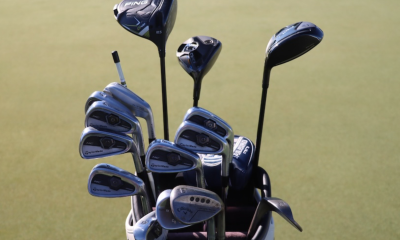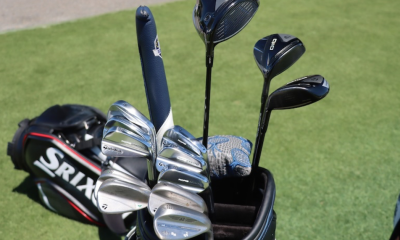Instruction
The 3 different levels of golf practice

“I would have practiced as hard, but I would have made my practice more meaningful. I would have worked more on my short game and putting. I would’ve done a lot more drills to make the practice more meaningful, and I would’ve added pressure to the practice as much as possible.” — Lee Westwood
Now here’s the rub. Practice is not monolithic! I approach practice as having three different, distinctive and separate curriculum and criteria.
- Level 1: Basic
- Level 2: Advanced
- Level 3: Extreme
Basic Practice (Level 1) by definition is “repeated exercise in or performance of an activity or skill so as to acquire or maintain proficiency in it.” Basically, it’s doing the same thing over and over again to get better at it. My favorite skill that requires practice is the 76-yard “flighted wedge.” I do it, and I recommend it be done at every range practice session. Additionally, I identify and then practice as many different “skills” that are required to hit different golf shots. I have found that a non-pressurized environment is the best way to practice in a basic model.
It goes without saying that golf is not played in a pressure-free environment, so basic practice doesn’t help us play golf. The prime objective of Level 2 Practice (Advanced Training) is to take what you do in Basic Practice to the golf course.
First, create on-course situations that require you to hit the shots you have practiced. There should be rewards for demonstrations of competence, and there should be consequences for demonstrations of incompetence
“When you practice, try to find a situation to fit the shot you’re trying to practice.” — Ben Hogan
For example, a major problem is the unevenness of the lies you will encounter during play as opposed to the lies you used for your drills. From marginal to extreme, lies are difficult to replicate on the practice tee. So, play a round of golf and move the ball into the most undesirable lie that is very close to where you are.
Another example would be duplicating the creativity that is sometimes required during actual play. The prime example of that would be the sensation of “being in-between clubs.” I would suggest that you play an occasional round of golf using only half of your clubs. Take two wedges instead of four. Take only the “odd” or “even” numbered irons. Look at not taking the driver, or not taking all of your fairway clubs. I have not taken my putter, which forced me putt with my sand wedge!
A third example would be to play a round of golf and deliberately miss every green in regulation. Should your ball accidentally finish on the green in regulation just move it off into the rough, a bunker or whatever else could use the extra attention. You can create games where your opponent moves your ball off the green into something that would be advantageous to him.
Level 2 Practice is conducted on the practice ground as well as on the course. What I do and recommend is to take each of the shots, skills and drills used in Level 1 and add some accountability to the range experience. I have my students and clients use a “Practice Book” to schedule activities and to keep track of improvement.
Author Note: I will send you a sample practice book page that many of my players actually use. Request it at [email protected].
Please be advised that Level 2 Practice can feature games, wagering or other forms of friendly competitions because they should only activate the lesser emotions of irritation, annoyance, anticipation, anxiousness, joy, pleasure and disappointment. Dealing with these feelings in practice will help you recognize and deal with the minor stresses experienced by most recreational golfers.
Stress is the major cause of “CHOKING.”
Stress, by definition “is a state of mental or emotional strain or tension resulting from adverse or very demanding circumstances.” Stress can ruin our ability to perform when we experience the major emotions such as fear, anger, shame, humiliation, euphoria, ridicule, betrayal, doubt and/or disbelief.
Level 3 Practice (Extreme Preparation) is on-course training sessions best suited for very serious competitive golfers. The more a player is able to compete in a simulated or controlled environment that accurately replicates the actual “pressures” that produce the kind of stresses that can effect performance, the better the player will perform when stressed in actual tournaments or events. Please be advised that Extreme Practice DOES NOT feature games, gambling or “friendly” competitions. They don’t control the conditions of play sufficiently to replicate the type of pressure that would induce “stress.”
“Simulation, which is a technique (not a technology) to replace and amplify real experiences with guided ones, often “immersive” in nature, that evoke or replicate substantial aspects of the real world in a fully interactive fashion.” For many years now, the medical profession has used simulations to train doctors, the military has used simulations to prepare troops for the realities of the battlefield and aviation has used simulators to train pilots. Simulating has the added benefits of being cost and time effective while producing verifiable results.
If it’s possible for airlines to replicate every possible scenario that a pilot could experience in the cockpit by using simulations, then why isn’t it possible to replicate situations, and subsequent emotional responses, that a competitive golfer could experience on the golf course? Let me give you an example of what I mean.
“I got nervous all the time, as nervous as the next guy. It’s just that I caught myself before it became destructive.” Jack Nicklaus
Recent events at the WGC-Dell Technologies Match Play gives us some evidence of the destructiveness of uncontrolled emotions. Justin Thomas said that he couldn’t get the thought out of his mind of becoming the No. 1-ranked player in the world should he defeat Bubba Watson in the semi-finals, which he failed to do.
“I haven’t had such a hard time not thinking about something so much,” Thomas said. “And that really sucked. I couldn’t stop thinking about it, to be perfectly honest.”
Then there was Ian Poulter being told that with his win over Louis Oosthuizen he had earned a spot in this years’ Masters tournament only to be told 10 minutes before his next match that he had not actually secured the coveted invitation. With elation, joy and satisfaction jerked away and replaced with disappointment, and possibly anger, the Englishman went out and got whipped by Kevin Kisner 8 & 6!
I concede that Justin Thomas’ and Ian Poulter’s situations were so unique that simulation-based practice and preparation techniques may not have been available to them, but now they both must know that their performance was effected negatively by mental stresses. And with that knowledge they may want to get tougher mentally. Level 3 Practice does that!
Not all that long ago, I was approached by a PGA Tour veteran for some on-course, one-on-one training. He was experiencing severe “choking” in pressurized short-game situations. So I took him out on the course and we replicated the exact shots he had problems with in the past. He demonstrated that he could perform each and every shot in a stress-free environment. We went into a “low-stress” training environment and his performance began to suffer. Then, at his urging to get “real,” we went into a “high-stress” practice mode and he melted down. Without going into details, he became so angry that not only couldn’t he hit golf shots, he tried to run me down with the golf cart as he retreated to the safety of his car.
Now, that’s not the end of the story. A few hours later, after some soul searching, he apologized for his lack of self-control and acknowledged that he had recognized the early signs of stress growing internally as we worked. We went back out onto the course and got back to work.
- LIKE117
- LEGIT12
- WOW6
- LOL1
- IDHT2
- FLOP3
- OB2
- SHANK16
Instruction
Clement: Laid-off or perfect fade? Across-the-line or perfect draw?

Some call the image on the left laid off, but if you are hitting a fade, this could be a perfect backswing for it! Same for across the line for a draw! Stop racking your brain with perceived mistakes and simply match backswing to shot shape!
- LIKE0
- LEGIT0
- WOW0
- LOL0
- IDHT0
- FLOP0
- OB0
- SHANK0
Instruction
The Wedge Guy: The easiest-to-learn golf basic

My golf learning began with this simple fact – if you don’t have a fundamentally sound hold on the golf club, it is practically impossible for your body to execute a fundamentally sound golf swing. I’m still a big believer that the golf swing is much easier to execute if you begin with the proper hold on the club.
As you might imagine, I come into contact with hundreds of golfers of all skill levels. And it is very rare to see a good player with a bad hold on the golf club. There are some exceptions, for sure, but they are very few and very far between, and they typically have beat so many balls with their poor grip that they’ve found a way to work around it.
The reality of biophysics is that the body moves only in certain ways – and the particulars of the way you hold the golf club can totally prevent a sound swing motion that allows the club to release properly through the impact zone. The wonderful thing is that anyone can learn how to put a fundamentally sound hold on the golf club, and you can practice it anywhere your hands are not otherwise engaged, like watching TV or just sitting and relaxing.
Whether you prefer an overlap, interlock or full-finger (not baseball!) grip on the club, the same fundamentals apply. Here are the major grip faults I see most often, in the order of the frequency:
Mis-aligned hands
By this I mean that the palms of the two hands are not parallel to each other. Too many golfers have a weak left hand and strong right, or vice versa. The easiest way to learn how to hold the club with your palms aligned properly is to grip a plain wooden ruler or yardstick. It forces the hands to align properly and shows you how that feels. If you grip and re-grip a yardstick several times, then grip a club, you’ll see that the learning curve is almost immediate.
The position of the grip in the upper/left hand
I also observe many golfers who have the butt of the grip too far into the heel pad of the upper hand (the left hand for right-handed players). It’s amazing how much easier it is to release the club through the ball if even 1/4-1/2″ of the butt is beyond the left heel pad. Try this yourself to see what I mean. Swing the club freely with just your left hand and notice the difference in its release from when you hold it at the end of the grip, versus gripping down even a half inch.
To help you really understand how this works, go to the range and hit shots with your five-iron gripped down a full inch to make the club the same length as your seven-iron. You will probably see an amazing shot shape difference, and likely not see as much distance loss as you would expect.
Too much lower (right) hand on the club
It seems like almost all golfers of 8-10 handicap or higher have the club too far into the palm of the lower hand, because that feels “good” if you are trying to control the path of the clubhead to the ball. But the golf swing is not an effort to hit at the ball – it is a swing of the club. The proper hold on the club has the grip underneath the pad at the base of the fingers. This will likely feel “weak” to you — like you cannot control the club like that. EXACTLY. You should not be trying to control the club with your lower/master hand.
Gripping too tightly
Nearly all golfers hold the club too tightly, which tenses up the forearms and prevents a proper release of the club through impact. In order for the club to move back and through properly, you must feel that the club is controlled by the last three fingers of the upper hand, and the middle two fingers of the lower hand. If you engage your thumbs and forefingers in “holding” the club, the result will almost always be a grip that is too tight. Try this for yourself. Hold the club in your upper hand only, and squeeze firmly with just the last three fingers, with the forefinger and thumb off the club entirely. You have good control, but your forearms are not tense. Then begin to squeeze down with your thumb and forefinger and observe the tensing of the entire forearm. This is the way we are made, so the key to preventing tenseness in the arms is to hold the club very lightly with the “pinchers” — the thumbs and forefingers.
So, those are what I believe are the four fundamentals of a good grip. Anyone can learn them in their home or office very quickly. There is no easier way to improve your ball striking consistency and add distance than giving more attention to the way you hold the golf club.
More from the Wedge Guy
- The Wedge Guy: Golf mastery begins with your wedge game
- The Wedge Guy: Why golf is 20 times harder than brain surgery
- The Wedge Guy: Musings on the golf ball rollback
- LIKE86
- LEGIT13
- WOW6
- LOL1
- IDHT0
- FLOP4
- OB1
- SHANK8
Instruction
Clement: Stop ripping off your swing with this drill!

Not the dreaded headcover under the armpit drill! As if your body is defective and can’t function by itself! Have you seen how incredible the human machine is with all the incredible feats of agility all kinds of athletes are accomplishing? You think your body is so defective (the good Lord is laughing his head off at you) that it needs a headcover tucked under the armpit so you can swing like T-Rex?
- LIKE0
- LEGIT2
- WOW2
- LOL0
- IDHT0
- FLOP0
- OB0
- SHANK2
-

 19th Hole2 weeks ago
19th Hole2 weeks agoDave Portnoy places monstrous outright bet for the 2024 Masters
-

 19th Hole2 weeks ago
19th Hole2 weeks agoTiger Woods arrives at 2024 Masters equipped with a putter that may surprise you
-

 19th Hole2 days ago
19th Hole2 days agoJustin Thomas on the equipment choice of Scottie Scheffler that he thinks is ‘weird’
-

 19th Hole2 days ago
19th Hole2 days ago‘Absolutely crazy’ – Major champ lays into Patrick Cantlay over his decision on final hole of RBC Heritage
-

 19th Hole3 weeks ago
19th Hole3 weeks agoReport: Tiger Woods has ‘eliminated sex’ in preparation for the 2024 Masters
-

 19th Hole1 week ago
19th Hole1 week agoTwo star names reportedly blanked Jon Rahm all week at the Masters
-

 19th Hole1 week ago
19th Hole1 week agoReport: LIV Golf identifies latest star name they hope to sign to breakaway tour
-

 19th Hole1 week ago
19th Hole1 week agoNeal Shipley presser ends in awkward fashion after reporter claims Tiger handed him note on 8th fairway





















lulu
Apr 20, 2018 at 3:08 pm
Practice? Practice? Did you say ‘practice’?!! Who needs to practice when you got super game improvement clubs in your WITB quiver of weapons? I got no time to practice. My fantastic clubs don’t need practice to perform. 😮
Devilsadvocate
Apr 20, 2018 at 6:09 am
Well how exactly do you get “high stress” practice? What kind of situation could you have put someone in while practicing that would make them feel like that? Explanation please
James
Apr 20, 2018 at 1:59 pm
2nd this comment. How do you make a high stress situation on a practice range?
James T
Apr 20, 2018 at 5:51 pm
Money. You leave $5 bills on the practice range for every failed shot. Or if you’re Justin Thomas you leave $100 bills.
millennial82
Apr 19, 2018 at 11:04 am
It’s clear now.. Thank you so much Ed!